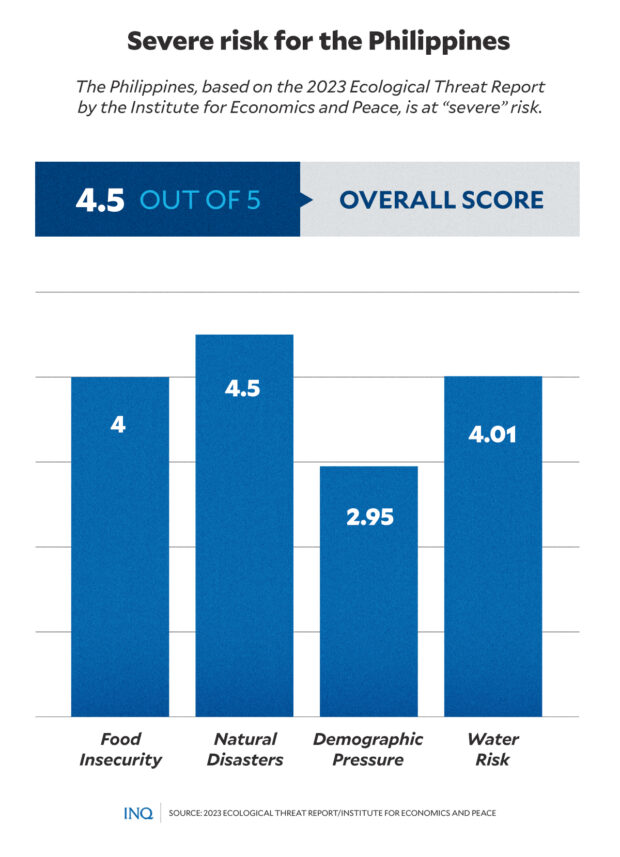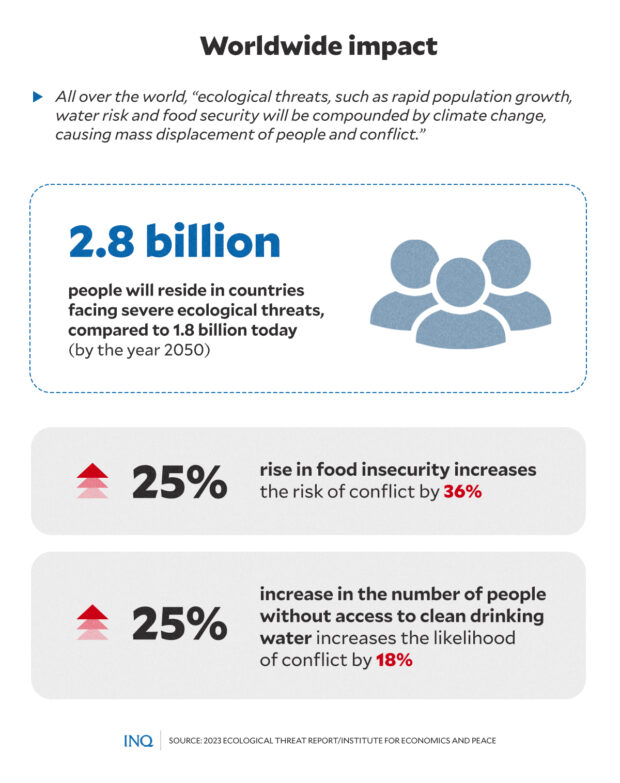PH at ‘severe’ risk of ecological threats seen to worsen conflicts, poverty
MANILA, Philippines—Aggravated by climate change, ecological threats—water and food shortage abetted by population growth- is likely to raise the risks of conflicts and mass displacement worldwide.
RELATED STORY: Don’t care about climate change? Wait until it hits you in the face
As the Institute for Economics and Peace (IEP) pointed out, without concerted action, present levels of ecological degradation will considerably worsen, intensifying existing social issues, like malnutrition and forced migration.
This was the reason that in its 2023 Ecological Threat Report (ETR), the IEP stressed the need to “build resilience to these threats” by making substantial investments now.
“Ecological threats will continue to create humanitarian emergencies, increase conflict and result in forced migration, unless there is a sustained effort to reverse the current trend,” it said.
Article continues after this advertisementBased on the ETR, which looked at ecological threats in 221 independent states and territories, the Philippines, with an overall score of 4.5 out of 5, is at “severe” risk of natural disasters, food and water shortages, and population pressure.
Article continues after this advertisementREAD: Winning the war vs climate change
The country, which is expected to have a population of almost 150 million by 2050, scored 4.5 for risk of natural disasters, 4.01 and 4 for risk of water and food insecurity, and 2.95 for risk of rapid population growth.
All over Southeast Asia, the Philippines is the seventh country at “severe” risk, next to Indonesia (4.51), Thailand (4.6), Laos (4.79), Timor Leste (4.96), Myanmar (5), and Cambodia (5).
Intensifying conflict
IEP said ecological threats increase the risk of conflict.
It explained that a 25 percent rise in food insecurity increases the risk of conflict by 36 percent, while the same level of water shortage and natural disasters increases the risk of conflict by 18 percent and 21 percent.
All over the world, IEP said by 2050, 2.8 billion people will reside in countries confronting severe ecological threats compared to 1.8 billion in 2023, with 1.1 billion of these people living in states with low societal resilience.
“The impact on conflict risk is greatest in areas with a history of conflict, a lack of resilience, and weak institutions,” it said, pointing out that these areas are especially prone to conflict after an ecological shock, like flood or drought.
It was stressed that “the magnitude of this impact will increase as the long-term effects of climate change start to take hold,” especially where long-term climate variation is an issue.
Food and water insecurity
For IEP, food insecurity remains an issue of significant concern, with prices now 33 percent higher than they were in 2016. It said there are 42 countries facing severe food insecurity.
By 2050, five billion people could be living in areas with high or severe food insecurity.
Water risk is also a significant ecological threat, and is “getting worse,” with an estimated two billion people all over the world not having regular access to safe drinking water.
These trends, the United Nations (UN) pointed out, are expected to worsen.
“It is likely that global warming will exceed 1.5°C during the 21st century, making it harder to stay below 2°C. This is likely to exacerbate ecological degradation and the underlying drivers of conflict,” it said.
Natural disasters
The risk posed by natural disasters continues to increase, too, with over 1.8 billion people living in areas that confront severe risk from natural disasters, IEP said in its report.
There is even a strong chance that more than five percent of the population will be severely impacted by a devastating natural hazard. There are 44 countries with both a high risk of natural disasters, and low resilience.
“The impact of extreme weather events is compounded when countries have low levels of resilience. The inability of many countries to deal with the impact of natural disasters has led to a greater need for disaster relief funding,” it said.
Last year, 35 percent of total funding from the UN Central Emergency Response Fund was dedicated to providing aid in the aftermath of natural disasters, compared to only 17 percent a decade ago.
Based on data from Oxfam, in the Philippines, while LGUs spend their 30 percent Quick Response Fund in response to actual disasters, they are less likely to make use of a significant share of the 70 percent fund for preparedness and mitigation.
READ: Ounce of prevention better than pound of cure in times of disaster—Oxfam tells LGUs
Swelling population
It was pointed out, too, by IEP that increasing demographic pressure compounds the risks caused by the rest of ecological threats, as rapid population growth increases strain on public resources and societal resilience.
Over 40 percent of the subnational areas in the world are expected to record population growth of more than 20 percent by 2050, including Manila in the Philippines, where the population is seen to hit 23.55 million.
For IEP, “ecological threats, societal resilience and low levels of peacefulness will not be resolved without concerted international action.”


